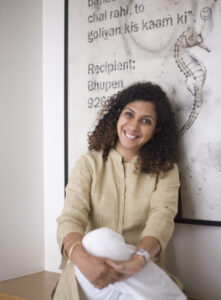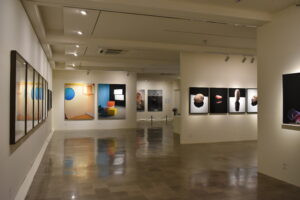Razvin Namdarian
 Parsis have an association with all things fine – we are known for our love of antiques, our collections of porcelain and crystal, our passion for classical music and theatre and the Parsi garas which are lauded as heritage pieces handed down, generation to generation. Little wonder then, that this culturally enlightened community has long been considered one that appreciates and promotes fine art.
Parsis have an association with all things fine – we are known for our love of antiques, our collections of porcelain and crystal, our passion for classical music and theatre and the Parsi garas which are lauded as heritage pieces handed down, generation to generation. Little wonder then, that this culturally enlightened community has long been considered one that appreciates and promotes fine art.
The Sir Jamsetjee Jeejeebhoy School of Art is an institution that lists several renowned artists as part of its alumni and is respected as one of the best art institutions in the country. ‘Apra’ Parsi artists like the legendary Jehangir Sabawalla, Pestonji Bomanji, Sorab Pithawalla Homi Patel, Mehlli Gobhai, Piloo Pochkhanawala, Shiavax Chavda, Adi Davierwala, Sooni Taraporevala, Geive Patel and Arzan Khambatta, among others, have left an indelible imprint on the canvas of India’s fine art history, creating a legacy that is appreciated around the world.
 Nurturing and guiding artists towards developing their innate talent is the initial part of their journey, but at the end of the day, art is also a business and art galleries have served a vital role in assisting artists to grow and reach an appreciative audience. Two renowned Parsi-owned art galleries which trace their history to the early 1960’s, are the Chemould Prescott Road and the Pundole’s Art Gallery. Shireen Gandhy, the current generation gallerist at Chemould, shares an interesting story about how Chemould started, “My father Kekoo Gandhy’s business started with framing and mouldings of frames. Chemould (which comes from chemical moulding) was the first ever framing shop. Artists needed frames and an Austrian artist, called Walter Langammer, nurturing younger art aspirants – (now the modern masters such as Husain, Raza, Ara etc) would bring them to the framing shop. My father’s vanity was at first the frames, but later it became what was within the frames… and the rest is history!”
Nurturing and guiding artists towards developing their innate talent is the initial part of their journey, but at the end of the day, art is also a business and art galleries have served a vital role in assisting artists to grow and reach an appreciative audience. Two renowned Parsi-owned art galleries which trace their history to the early 1960’s, are the Chemould Prescott Road and the Pundole’s Art Gallery. Shireen Gandhy, the current generation gallerist at Chemould, shares an interesting story about how Chemould started, “My father Kekoo Gandhy’s business started with framing and mouldings of frames. Chemould (which comes from chemical moulding) was the first ever framing shop. Artists needed frames and an Austrian artist, called Walter Langammer, nurturing younger art aspirants – (now the modern masters such as Husain, Raza, Ara etc) would bring them to the framing shop. My father’s vanity was at first the frames, but later it became what was within the frames… and the rest is history!”
Pundole’s finds its unlikely antecedents in a watch and clock shop at Fountain, Mumbai, which was established when no imports were allowed into the country. It was in 1963 that the family decided to set up a gallery by splitting the store into two sections and it stayed that way till the ‘80s. Today, Pundole’s is a privately owned auction house managed by Dadiba and Khorshed Pundole.
As Shireen rightly says, in the art world, “community was a family that went beyond being Parsi,” but that being said, this gallery which recently celebrated its 60th year, has seen several Parsi artists exhibit their works with them, including Piloo Pochkhanawala and Adi Davierwala. In fact, the gallery also hosted a show titled, ‘Hearts on Fire’ curated by Sarica Robyn Balsari, which presented works by thirteen artists, highlighting the theme – Parsi identity. The artists included Sooni Taraporevala, Porus Vimadalal, Divya Cowasji, Aaran Patel, Farzin Adenwalla, Iyanah Batlivala and Perin Coyaji Pudumjee.
When it comes to buying and collecting art, some of the best collections are owned by Parsi stalwarts, like Jehangir Nicholson and Dr. Homi Bhabha. Of course, as Shireen and Dadiba reason, the Parsis had both – the sense and the means that encouraged the passion to collect art. The educated Parsis had the cultural background and exposure that helped them appreciate and understand art, and coming from illustrious families provided them with the means to build their art collections.
Their enviable collections boast of museum quality works by masters of Indian contemporary art, including F N Souza, S H Raza, M F Hussain, Gaitonde and Tyeb Hussain. In addition, the National Centre for Performing Arts houses the art collection of Homi’s brother, Jamshed, who was also an avid art collector. The Chhatrapati Shivaji Maharaj Vastu Sangrahalaya exhibits the art collection of Jehangir Nicholson in his eponymous art gallery in the museum’s east wing.
As Dadiba rightly points out, “we are fortunate that these great Parsi collectors have donated their art collections, which are now available for viewing in the public domain.” Other Parsi art collectors include Naval Vakil and Ernevaz K. Dubash, whose collected works still come up for auction on occasion.
Looking to the future, one can say that the Parsi love for fine art continues to thrive There are young Parsi artists doing interesting work. Shireen names the photo-based work of Divya Cowasji as one such example. Adil Writer works with ceramics and Jenaifer Daruwalla is a self-taught artist who uses alcohol inks to create sublime abstract works.
Moreover, our Parsi attitude towards collecting also has not diminished and those who can afford it, do see art as an investment that is as much about finance as it is about nourishing the soul. As Shireen says, even today “you have a collector like Dara Mehta (now in his 50s) who has one of the best collections of modern art as an individual.” Parvez Damania is another who has an enviable art collection. As Dadiba rightly puts it, “Parsis still appreciate art,” amongst the other finer things in life!
- તમે ઇન્જેક્શન આપેલા તરબૂચ તો નથી ખાઈ રહ્યા ને? - 27 April2024
- પિતાના હાથની છાપ.. - 27 April2024
- વિસ્પી ખરાડી ફિટ ઈન્ડિયા મૂવમેન્ટનાબ્રાન્ડ એમ્બેસેડર તરીકે નિયુક્ત - 27 April2024
